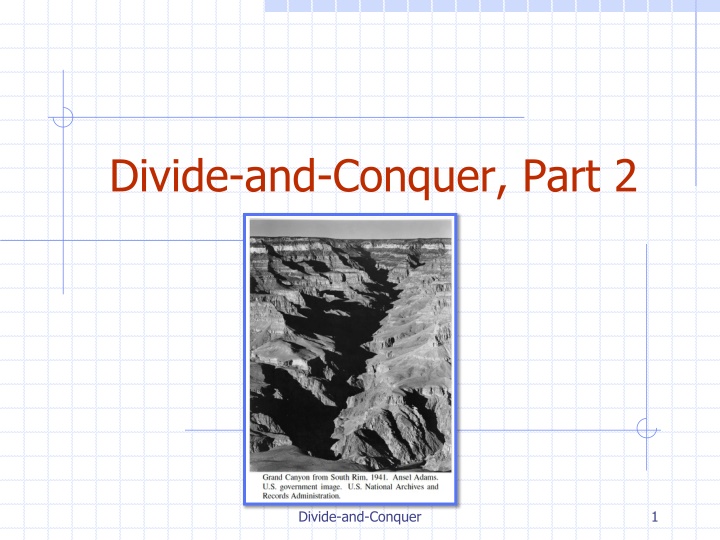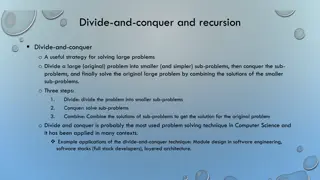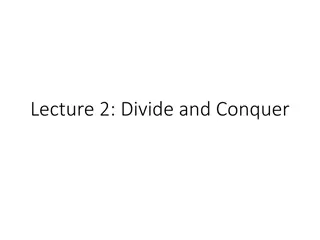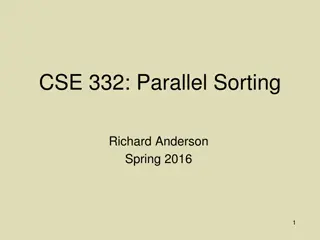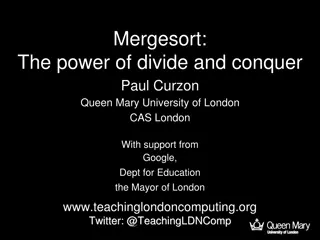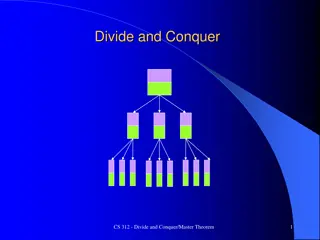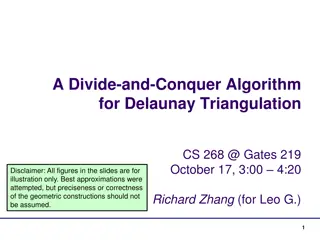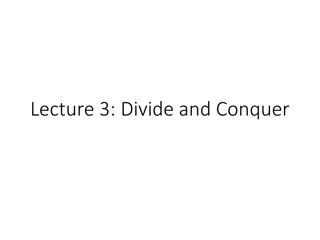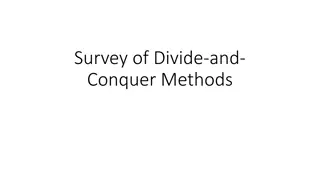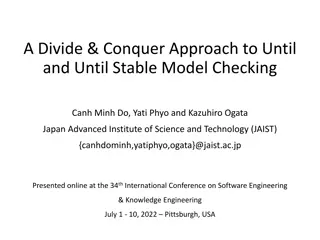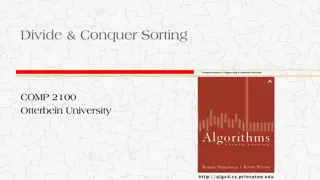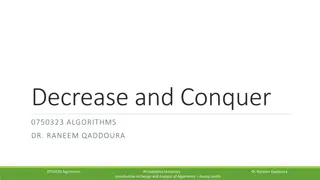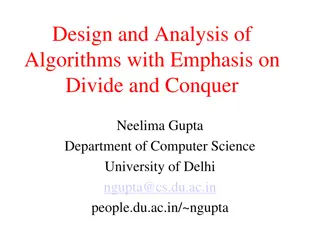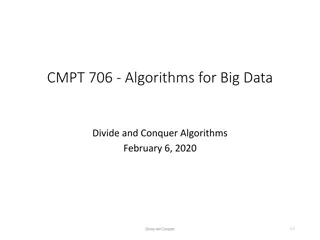Efficient Divide-and-Conquer Algorithms and Applications
Explore the power of divide-and-conquer algorithms through examples like integer arithmetic operations and the Maxima Set Problem. Learn how to improve multiplication efficiency using Karatsuba's algorithm. Understand the concept of maximum points in a set and how divide-and-conquer can efficiently solve the Maxima Set Problem for optimization tasks.
Download Presentation

Please find below an Image/Link to download the presentation.
The content on the website is provided AS IS for your information and personal use only. It may not be sold, licensed, or shared on other websites without obtaining consent from the author.If you encounter any issues during the download, it is possible that the publisher has removed the file from their server.
You are allowed to download the files provided on this website for personal or commercial use, subject to the condition that they are used lawfully. All files are the property of their respective owners.
The content on the website is provided AS IS for your information and personal use only. It may not be sold, licensed, or shared on other websites without obtaining consent from the author.
E N D
Presentation Transcript
Divide-and-Conquer, Part 2 Divide-and-Conquer 1
Integer Arithmetic Add. Given two n-digit integers a and b, compute a + b. O(n) bit operations. 1 1 0 1 0 1 0 1 * 0 1 1 1 1 1 0 1 Multiply. Given two n-digit integers a and b, compute a b. Brute force solution: (n2) bit operations. 1 1 0 1 0 1 0 1 0 0 0 0 0 0 0 0 0 0 1 1 0 1 0 1 0 1 0 1 1 0 1 0 1 0 1 0 1 1 1 1 1 1 0 1 1 1 0 1 0 1 0 1 0 Multiply 1 0 1 0 1 1 0 1 1 1 0 1 0 1 0 1 0 + 0 1 1 1 1 1 0 1 1 1 0 1 0 1 0 1 0 1 0 0 1 0 1 0 1 0 0 0 0 0 0 0 0 0 0 0 1 1 0 1 0 0 0 0 0 0 0 0 0 0 1 0 Add 2
Integer Multiplication Algorithm: Multiply two n-bit integers I and J. Divide step: Split I and J into high-order and low-order bits n h J J J + = 2 = + / 2 2 I I I l / 2 n h l We can then define I*J by multiplying the parts and adding: J I I J I + = 2 2 = + + / 2 / 2 n n * ( 2 ) * ( 2 ) J h J l h 2 / l + + / 2 n n n 2 I I J I J I J h h h l l h l l So, T(n) = 4T(n/2) + n, which implies T(n) is O(n2). But that is no better than the algorithm we learned in grade school. Divide-and-Conquer 3
An Improved Multiplication Algorithm (Karatsuba) Algorithm: Multiply two n-bit integers I and J. Divide step: Split I and J into high-order and low-order bits n h J J = 2 = + / 2 2 I I I l + / 2 n J h l Observe that there is a different way to multiply parts: n h h I J I J I J I + + = 2 ) ( 2 = + + + + / 2 n * 2 [( )( ) 2 ] I J I J I I J J I J I + J I J h l l h h I h J l l l 2 ] l = + + + + / 2 n n 2 [( ) J I J I J I J h h h J l l J l h 2 h l h h h l l l l + / n n I J I I I J h h h l l h l l So, T(n) = 3T(n/2) + n, which implies T(n) is O(nlog23), by the Master Theorem. Thus, T(n) is O(n1.585). Divide-and-Conquer 4
The Maxima Set Problem We say that a point (x, y) is a maximum point in a set if there is no other point, (x , y ), in that set such that x x and y y . The maximum points are the best potential choices based on these two dimensions and finding all of them is the maxima set problem. We can efficiently find all the maxima points by divide-and-conquer. Here the set is {A,H,I,G,D}. Divide-and-Conquer 5
Solving the Maxima Set Problem Let us now return to the problem of finding a maxima set for a set, S, of n points in the plane. This problem is motivated from multi-objective optimization, where we are interested in optimizing choices that depend on multiple variables. For instance, in the introduction we used the example of someone wishing to optimize hotels based on the two variables of pool size and restaurant quality. Again, a point is a maximum point in S if there is no other point, (x , y ), in S such that x x and y y . Divide-and-Conquer 6
Divide-and-Conquer Solution Given a set, S, of n points in the plane, there is a simple divide-and-conquer algorithm for constructing the maxima set of points in S. If n 1, the maxima set is just S itself. Otherwise, let p be the median point in S according to a lexicographic ordering of the points in S, that is, where we order based primarily on x- coordinates and then by y-coordinates if there are ties. Next, we recursively solve the maxima-set problem for the set of points on the left of this line and also for the points on the right. Given these solutions, the maxima set of points on the right are also maxima points for S. But some of the maxima points for the left set might be dominated by a point from the right, namely the point, q, that is leftmost. So then we do a scan of the left set of maxima, removing any points that are dominated by q, until reaching the point where q s dominance extends. The union of remaining set of maxima from the left and the maxima set from the right is the set of maxima for S. Divide-and-Conquer 7
Example for the Combine Step Divide-and-Conquer 8
Pseudo-code Divide-and-Conquer 9
A Little Implementation Detail Before we analyze the divide-and-conquer maxima-set algorithm, there is a little implementation detail that we need to work out. Namely, there is the issue of how to efficiently find the point, p, that is the median point in a lexicographical ordering of the points in S according to their (x, y)-coordinates. There are two immediate possibilities: One choice is to use a linear-time median-finding algorithm, such as that given in Section 9.2. This achieves a good asymptotic running time, but adds some implementation complexity. Another choice is to sort the points in S lexicographically by their (x, y)-coordinates as a preprocessing step, prior to calling the MaxmaSet algorithm on S. Given this preprocessing step, the median point is simply the point in the middle of the list. Divide-and-Conquer 10
Analysis In either case, the rest of the non-recursive steps can be performed in O(n) time, so this implies that, ignoring floor and ceiling functions (as allowed by the analysis of Exercise C-11.5), the running time for the divide-and-conquer maxima-set algorithm can be specified as follows (where b is a constant): + ) 2 / ( 2 n T if 2 b n = ( ) T n if 2 bn n Thus, according to the Master Theorem, this algorithm runs in O(n log n) time. Divide-and-Conquer 11
